Kandy… war ursprünglich Kanda Uda Pas Rata, „Königreich der fünf Berge“. Dann kamen die Portugiesen und kürzten auf Kanda ab, was den Briten später immer noch nicht flüssig genug von der Zunge ging und die deshalb Kandy daraus machten. Und angeblich nennen die Lokalen sie auch Maha Nuwara, die „Große Stadt“. Zwar hat Kandy wohl 160.000 Einwohner, aber alles für den Touristen interessante ist (reiner Fußweg) wohl in einer guten Stunde abgegrast: einmal um den Kady Lake.
Kandy… was originally called Kanda Uda Pas Rata, „Kingdom of the five mountains“. Then the Portuguese came and called it simply Kanda but apparently that still was a tongue twister for the British who called it Kandy. Apparently, to the locals it is also still Maha Nuwara, the „Big City“. Which seems a bit far fetched from a tourist point of view because despite a population of 160,000 anything of interest can be passed on a one-hour stroll: circling Kandy Lake.
Auf einem der fünf Hügel ist ein buddhistischer Tempel mit allem drum und dran: besteigbare weiße Buddha-Statue, die weit ins Umland leuchtet, Bodhi-Baum und viele Schreine… inkl. eines hinduistischen Schreins, den ich gegen Abgabe einer Spende auch mal fotografieren durfte. Segen habe ich aber keinen bekommen. Vielleicht war die Spende zu klein? Und auch immer noch fehlt mir die Antwort auf die Frage, warum in so vielen (allen?) buddhistischen Tempeln auch der Hindu-Schrein nicht fehlt.
There’s a Buddhist temple on one of the five mountains: with a huge white Buddha statue that can be seen from far away (and that can be climbed), a bodhi tree and numerous shrines… including a Hindu shrine which I was allowed to photograph in return for a donation. But I didn’t get a blessing – maybe the donation was not considered generous enough? And still nobody could give me a clear answer of why there are Hindu shrines in just about every Buddhist temple.
Aber zurück nach Kandy. Der 26.01. war ein buddhistischer Feiertag (und somit alle von Buddhisten geführten Geschäfte geschlossen): es war Vollmond. Und jeder Vollmond ist ein Feiertag. Da in Kandy der berühmte Zahntempel steht, war von der Puja, die wir in ihrer alltäglichen Form ja schon in Anuradhapura erlebt hatten, was ganz besonderes zu erwarten.
But let’s get back to Kandy. January 26 was a Buddhist holiday (and as a consequence all shops owned by Buddhists were closed): it was a full moon. And every full moon is a holiday. As Kandy is home to the famous Tooth Temple we suspected the pooja, which we had already visited on a normal day in Anuradhapura, to be something really special.
Der Tempel des Heiligen Zahns liegt eigentlich malerisch am Kandy Lake. Der jetzt noch bestehende Hauptbau ist aus dem 17. Jahrhundert und wurde immer wieder verändert und erweitert. Vom ursprünglichen Tempel aus dem 16. Jahrhundert ist nichts mehr übrig. Dass er nur „eigentlich“ malerisch liegt beruht darauf, dass er und ein riesiges Areal drumherum durch einen hohen Zaun von der Uferpromenade abgetrennt sind und man durch Sicherheitsschleusen durch muss, um dorthin zu gelangen. Diese Maßnahmen wurden nach einem verheerenden Attentat 1998 vorgenommen.
The Temple of the Holy Tooth is situated somehow quite picturesquely by Kandy Lake. The current main building was erected in the 17th century but was constantly changed and added to. There’s nothing left of the original 16th century structure. That it is „somehow“ situated picturesquely is due to the fact that a very high fence surrounds the temple and a large area in front of it and that you have to pass security checkpoints before entering. These measures were taken after a devastating terror attack in 1998.
Schon in Polonnaruwa hatten wir es ja mit einer Zahnterrasse zu tun, jetzt mit einem Zahntempel. Und da gibt es noch einige ähnliche Beispiele. Und immer geht es um einen Zahn Buddhas. Da hatten wir uns schon gefragt, wieviele Zähne den Buddha wohl gehabt haben kann oder ob es sich vielleicht gar nicht um eine echte Reliquie handeln kann? Aber es stellt sich heraus, dass es immer der selbe Zahn war, der von einem Ort zum anderen gebracht wurde. Nachdem sie lange Jahre im indischen Kalinga aufbewahrt wurde, wurde sie 310 n.Chr. auf abenteuerlichem Weg nach Sri Lanka (Anuradhapura) gebracht: versteckt im Haarknoten einer Königstochter, die sie vor Kriegswirren in Sicherheit bringen sollte. Mit zahlreichen Zwischenstationen erreichte sie dann 1592 Kandy und der Tempel in seiner ersten Fassung wurde erbaut.
We had already been to the Tooth Terrace in Polonnaruwa and now it’s the Tooth Temple. And there are a few more examples like that. And it’s always about a tooth of Buddha. We had already started wondering just how many teeth he could possibly have had or even questioned the authenticity of the teeth. But it turns out that it’s always about the same tooth that had been brought from one place to the other over the centuries. Its first home was in Kalinga, India, for many, many years but then in 310 AD it found its adventurous way to Sri Lanka (Anuradhapura): it was hidden in the hair knot of a king’s daughter who was trying to get it out of harm’s way in a war. It finally reached Kandy in 1592 with many a stopover and the temple was built.
Neben dem Zahntempel gibt es noch viele weitere Gebäude, bspw. eine königliche Audienzhalle, nach allen Seiten offen – ein Walmdach, das von einer Vielzahl detailliert verzierter Holzsäulen getragen wird. Ganz in der Nähe ist auch das Raja Tusker Museum, was ziemlich ausgefallenes. Dort ist der ausgestopfte Elefant Raja Tusker zu sehen, der über 50 Jahre die ehrenvollste Aufgabe erledigen durfte: den Transport der Zahnreliquie. Wer sein(e) Nachfolger ist/sind, haben wir nicht in Erfahrung bringen können.
In addition to the Tooth Temple there are a number of other buildings in the huge compound, e.g. the Royal Reception Hall, without walls, just a roof that is carried by countless intricately decorated wooden pillars. Right next to it is the rather bizarre Raja Tusker Museum. You can admire the largest example of taxidermy I’ve ever seen: the elephant Raja Tusker who was „employed“ for only the most honorable work for over 50 years: the transport of the tooth. There was no mention of any possible successor(s).
Wir haben uns den Komplex schon nachmittags einmal angesehen, vor der Puja um 18:30 Uhr, und schon zu dem Zeitpunkt war es ein Massenspektakel. Trotz einiger Hinweisschilder im Inneren fand ich hatte der ganze Bau etwas von einem Labyrinth. Zu Beginn durchschreitet man einen mit stilisierten Lotusblüten bemalten Gang, um die Halle der Trommler zu erreichen. Die besuchten wir auch nochmal zur Puja, aber es war absolut ohrenbetäubend – ich war nicht die einzige, die sich die Ohren zugehalten hat.
We went to see the temple building in the afternoon already, before the pooja started at 6:30pm and already there were huge crowds. There were some signs of where to find what inside but still I found it labyrinthine. You enter the building(s) via a hallway that is painted with lotus flowers to reach the hall of the drummers. We went there again during the pooja but it was incredibly loud – I wasn’t the only one to cover their ears.
Die Bibliothek war klitzeklein – auf jeden Fall die, die öffentlich zugänglich war… vielleicht gibt es da ja noch ganz andere. Für mich war sie trotzdem interessant, weil die Vitrinen voller Palmblattbücher waren. Ich habe mir nur Romane und (Auto-)Biographien zu Sri Lanka als Lesestoff mitgebracht und fast überall werden diese Bücher erwähnt: etwa 50cm lang, nicht breiter als 10cm und mit wunderschönen Holzdeckeln. Aber auch den Schrein der Zahnreliquie haben wir im Vorbeischieben sehen können:
The library was very small – at least the one that was open to the public… maybe there are more rooms than just that one. I found it interesting anyway because the glass cases featured mainly (for lack of a better word a direct translation from German): palm leaf books. I’ve only brought novels and some (auto)biographies on Sri Lanka(ns) and so far they were mentioned in every single one: they are about 50cm long and no wider than 10cm, adorned with beautiful wooden covers. But we were also able to see the shrine where the tooth is kept:
Den eigentlichen Zahn kann man nur alle soundsoviel Jahre sehen und das nächste Mal wird es wohl 2018 wieder der Fall sein. Bis dahin muss man mit einer Nachbildung des Eckzahns im Museum vorlieb nehmen. Dass die jedoch einen menschlichen Eckzahn darstellen soll… da kam ich ans Zweifeln. Auch dieser kleine Sri Lanker ist offenbar noch nicht ganz überzeugt und hat die dem Buddhismus innewohnende Friedfertigkeit noch nicht ganz verinnerlicht (in diesem Moment gerade sehe ich Robert de Niro in Taxi Driver vor mir: „Are you talkin‘ to me??“ so im Sinne von „Willst du Stress??“):
You can see the actual tooth only every so often and the next chance is in 2018. Until then you can only see a replica in the museum. But it didn’t really look like a human tooth to me…And this little Sri Lankan apparently still has his doubts, too, and has not really found his way to Buddhism’s love of peace (in fact, just now Robert de Niro in Taxi Driver popped up before my mind’s eye… „Are you talkin‘ to me??“):
Wobei andere ob der komischen hellhäutigen Frau, die sich auf den heißen Stein- und Asphaltflächen barfuß nur von einem Schatten in den nächsten rettet, bevor sich die Haut ablöst, etwas irritiert dreinschaut:
Others look rather confused at this remarkably light skinned lady who does her own little barefoot dance on the the hot stone and asphalt surfaces, hurrying from shadow to shadow before the skin peels off:
Und dann saßen wir noch ein Weilchen am Rand der Königlichen Audienzhalle und beobachteten das Treiben im Sonnenuntergang…
And then we were sitting on the edge of the Royal Audience Hall for a bit, watching what was going on while the sun was setting…
… und darüber hinaus. Kann man erkennen, dass hier Leute dabei sind, Räucherstäbchen anzuzünden?
…and beyond. Can you tell that these are people lighting incense sticks?
Und als wäre er bestellt, stand der das alles auslösende Mond voll über dem Tempel, als wir uns dann auf Richtung Abendessen und Hotel machten.
And as if upon order, the full moon which was the reason for all this happening rose above the temple when we were leaving again, for dinner and a quiet night at the hotel.
Das nächste Mal mehr von unterwegs mit einem bislang nicht genutzten Verkehrsmittel!
And next time you’ll hear all about using a mode of transport we haven’t used before!
Barbara


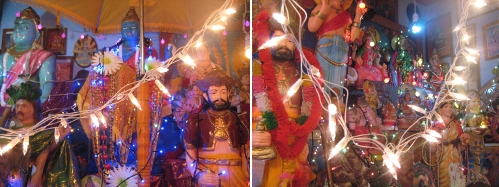
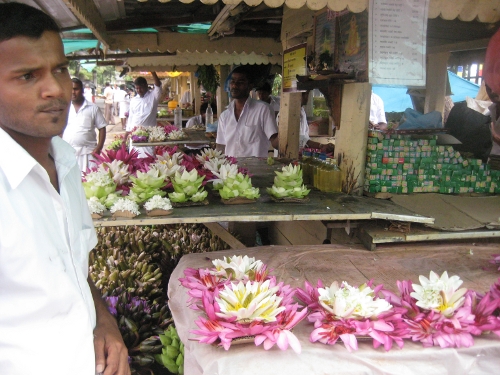



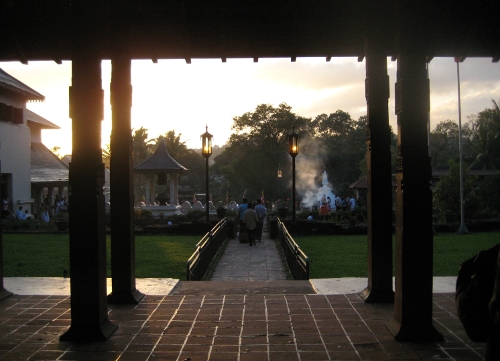

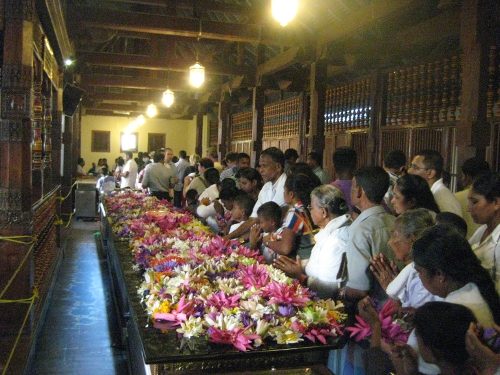



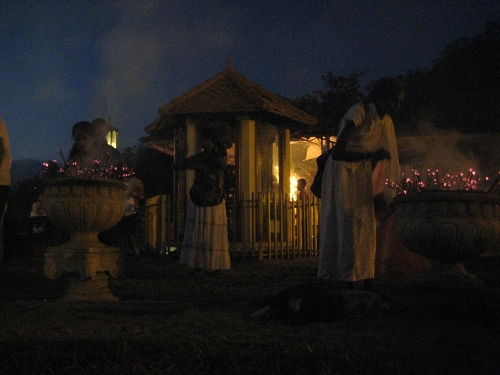
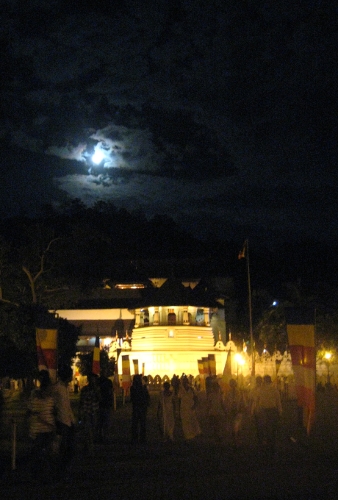
Love the stories (history) and the pictures!
Very interesting all of it!
LikeLike
Thanks for taking the time out of your travels to post photos and comments. I appreciate the „tour“ with you! Keep enjoying yourself!
LikeLike